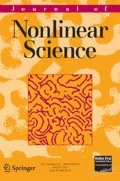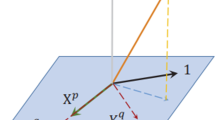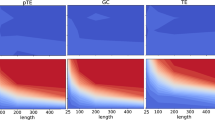Abstract
In this paper, we provide a novel approach to capture causal interaction in a dynamical system from time series data. In Sinha and Vaidya (in: IEEE conference on decision and control, pp 7329–7334, 2016), we have shown that the existing measures of information transfer, namely directed information, Granger causality and transfer entropy, fail to capture the causal interaction in a dynamical system and proposed a new definition of information transfer that captures direct causal interactions. The novelty of the information transfer definition used in this paper is the fact that it can differentiate between direct and indirect influences Sinha and Vaidya (2016). The main contribution of this paper is to show that the proposed definition of information transfers in Sinha and Vaidya (2016) and Sinha and Vaidya (in: Indian control conference, pp 303–308, 2017) can be computed from time series data, and thus, the direct influences in a dynamical system can be identified from time series data. We use transfer operator theoretic framework, involving Perron–Frobenius and Koopman operators for the data-driven approximation of the system dynamics and computation of information transfer. Several examples, involving linear and nonlinear system dynamics, are presented to verify the efficiency of the developed algorithm.










Similar content being viewed by others
Notes
For convenience of notation, from here on we denote the entropy of any variable x as H(x), instead of \(H(\rho (x))\).
with some abuse of notation we are using the same notation for the P–F operator defined on the space of measure and densities.
References
Adebayo, J., Southwick, T., Chetty, V., Yeung, E., Yuan, Y., Goncalves, J., Grose, J., Prince, J. Stan, G.-B., Warnick, S.: Dynamical structure function identifiability conditions enabling signal structure reconstruction. In: 2012 IEEE 51st Annual Conference on Decision and Control (CDC), IEEE. pp. 4635–4641 (2012)
Brunton, S.L., Proctor, J.L., Kutz, J.N.: Discovering governing equations from data by sparse identification of nonlinear dynamical systems. Proc. Natl. Acad. Sci. 113(15), 3932–3937 (2016)
Caramanis, C., Mannor, S., Xu, H.: 14 robust optimization in machine learning. Optim. Mach. Learn. 20, 369 (2012)
Chow, J., Kokotovic, P.: Time scale modeling of sparse dynamic networks. IEEE Trans. Autom. Control 30(8), 714–722 (1985)
Crnjaric-Zic, N., Macesic, S., Mezic, I.: Koopman operator spectrum for random dynamical system, arXiv preprint arXiv:1711.03146 (2017)
Dawson, S.T., Hemati, M.S., Williams, M.O., Rowley, C.W.: Characterizing and correcting for the effect of sensor noise in the dynamic mode decomposition. Exp. Fluids 57(3), 42 (2016)
Granger, C.W.J.: Investigating causal relations by econometrics models and cross-spectral methods. Econometrica 37(3), 424–438 (1969a)
Granger, C.W.: Investigating causal relations by econometric models and cross-spectral methods. Econom. J. Econom. Soc. 23, 424–438 (1969b)
Granger, C.W.J.: Testing for causality. J. Econ. Dyn. Control 2, 329–352 (1980)
Hemati, M.S., Rowley, C.W., Deem, E.A., Cattafesta, L.N.: De-biasing the dynamic mode decomposition for applied koopman spectral analysis of noisy datasets. Theor. Comput. Fluid Dyn. 31(4), 349–368 (2017)
Huang, B., Vaidya, U.: Data-driven approximation of transfer operators: naturally structured dynamic mode decomposition. arXiv:1709.06203 (2016)
Jovanović, M.R., Schmid, P.J., Nichols, J.W.: Sparsity-promoting dynamic mode decomposition. Phys. Fluids 26(2), 024103 (2014)
Kramer, G.: Directed information for channels with feedback. In: Ph.D. Thesis, Swiss Federal Institute of Technology Zurich (1998)
Kühnert, C., Beyerer, J.: Data-driven methods for the detection of causal structures in process technology. Machines 2(4), 255–274 (2014)
Lasota, A., Mackey, M.C.: Chaos, Fractals, and Noise: Stochastic Aspects of Dynamics. Springer, New York (1994)
Liang, X.S., Kleeman, R.: Information transfer between dynamical system components. Phys. Rev. Lett. 95, 244101 (2005)
Massey, J.L.: Causality, feedback and directed information. In: Proceedings of International Symposium on Information Theory and Its Applications, Waikiki, Hawai (1990)
Materassi, D., Salapaka, M.V.: On the problem of reconstructing an unknown topology via locality properties of the wiener filter. IEEE Trans. Autom. Control 57(7), 1765–1777 (2012)
Mooij, J.M., Peters, J., Janzing, D., Zscheischler, J., Schölkopf, B.: Distinguishing cause from effect using observational data: methods and benchmarks. J. Mach. Learn. Res. 17(32), 1–102 (2016)
Pearl, J.: Probabilistic Reasoning in Intelligent Systems: Networks of Plausible Inference. Morgan Kaufmann, Burlington (2014)
Rao, D.J.S.A., Hero, A.O., Engel, J.D.: Inference of biologically relevant gene influence networks using the directed information criterion. In: Proceedings of ICASSP, Toulouse, France (2006)
Rao, D.J.S.A., Hero, A.O., Engel, J.D.: Motif discovery in tissue-specific regulatory sequences using directed information. EURASIP J. Bioinform. Syst. Biol. 2007, 13853 (2007)
Schmid, P.J.: Dynamic mode decomposition of numerical and experimental data. J. Fluid Mech. 656, 5–28 (2010)
Schreiber, T.: Measuring information transfer. Phys. Rev. Lett. 85(2), 461–464 (2000)
Shu, Y., Zhao, J.: Data-driven causal inference based on a modified transfer entropy. Comput. Chem. Eng. 57, 173–180 (2013)
Sims, C.A.: Money, income and causality. Am. Econ. Rev. 62, 540–552 (1972)
Sinha, S., Vaidya, U.: Causality preserving information transfer measure for control dynamical system. In: IEEE Conference on Decision and Control, pp. 7329–7334 (2016)
Sinha, S., Vaidya, U.: On information transfer in discrete dynamical systems. In: Indian Control Conference, pp. 303–308 (2017)
Sinha, S., Huang, B., Vaidya, U.: Robust approximation of koopman operator and prediction in random dynamical systems. In: 2018 Annual American Control Conference (ACC), IEEE. pp. 5491–5496 (2018)
Sinha, S., Huang, B., Vaidya, U.: On robust computation of koopman operator and prediction in random dynamical systems. J. Nonlinear Sci. 20, 1–34 (2019)
Spirtes, P., Glymour, C.N., Scheines, R.: Causation, Prediction, and Search. MIT press, Cambridge (2000)
Sporns, O.: The Networks of the Brain. MIT Press, Cambridge (2010)
Steeg, G.V., Galstyan, A.: Information transfer in social media. In: Proceedings of the 21st International Conference on World Wide Web, New York, pp. 509–518 (2012)
Takeishi, N., Kawahara, Y., Yairi, T.: Subspace dynamic mode decomposition for stochastic koopman analysis. Phys. Rev. E 96(3), 033310 (2017)
Tatonetti, N.P., Patrick, P.Y., Daneshjou, R., Altman, R.B.: Data-driven prediction of drug effects and interactions. Sci. Transl. Med. 4(125), 125ra31–125ra31 (2012)
Williams, M.O., Kevrekidis, I.G., Rowley, C.W.: A data-driven approximation of the koopman operator: extending dynamic mode decomposition. J. Nonlinear Sci. 25(6), 1307–1346 (2015)
Zou, C., Feng, J.: Granger causality vs. dynamic bayesian network inference: a comparative study. BMC Bioinform. 10(1), 122 (2009)
Author information
Authors and Affiliations
Corresponding author
Additional information
Communicated by Clarence W. Rowley.
Publisher's Note
Springer Nature remains neutral with regard to jurisdictional claims in published maps and institutional affiliations.
Rights and permissions
About this article
Cite this article
Sinha, S., Vaidya, U. On Data-Driven Computation of Information Transfer for Causal Inference in Discrete-Time Dynamical Systems. J Nonlinear Sci 30, 1651–1676 (2020). https://doi.org/10.1007/s00332-020-09620-1
Received:
Accepted:
Published:
Issue Date:
DOI: https://doi.org/10.1007/s00332-020-09620-1




